From Liverpool to Wolverhampton Wanderers, teams in the English Premier League often credit their fans’ presence for boosting their performance on match day. Most of those fans agree they’re an asset. So can we use statistics to find out whose support makes the most difference?
Home advantage
Home advantage – whereby a team plays better when on its own turf – has been a widely studied phenomena in football1,2,3,4,5,7. Most studies show that there is a significant home advantage. Crucially, Coso et al.2 found that the key differentiating factor as to who won Spain’s LaLiga, is a team’s away performance, making it important to uncover reasons for the widely observed home advantage. The general consensus is that the advantage mostly comes from reduced travel, referee bias, and the presence of home fans (which largely cause the referee bias). However, it has traditionally been challenging to isolate the impact of fans and quantify the extent to which each team’s supporters influence their team’s performance.
The majority of the 2020–21 Premier League season was played without fans due to the Covid-19 pandemic. A few games saw minor attendance, but not close to levels seen in previous seasons, and stadiums were largely empty. This gives us the perfect opportunity to determine how much impact the home fans truly have and for which teams the impact is greatest – helping to settle many longstanding pub debates among fans.
In this article, historical English Premier League data from the last ten seasons is analysed; from the 2014–15 season to the recent 2023–24 season. Using this data, the following questions will be discussed:
- Do the fans, in general, increase the home advantage across the Premier League?
- Which Premier League team has the most impactful fans?
Home advantage across the league The impact of the pandemic was immediately felt in the Premier League. With few fans in attendance, the 2020–21 season saw a dramatic decrease in the home win rate and an increase in the away win rate (Figure 1). Compared to all other seasons considered, only the 2020–21 season had a higher away win rate than home. This difference was negligible, suggesting that with no fans, there is no home or away advantage. This further provides some evidence that the travel aspect of playing away has no impact on the away team. This is in contrast to Oberhofer et al.5 , who found that travel distance increases the away team’s likelihood of conceding goals and has an insignificant impact on scoring goals. These findings were for the German Premier League between the seasons 1986–87 and 2006–07. On the other hand, Armatas and Pollard1 found that travel distance had no impact on the game outcome in the Greek Superleague. It is possible that this effect is not present for modern English Premier League teams due to their large budgets, which accommodate the best hotels and travel methods.
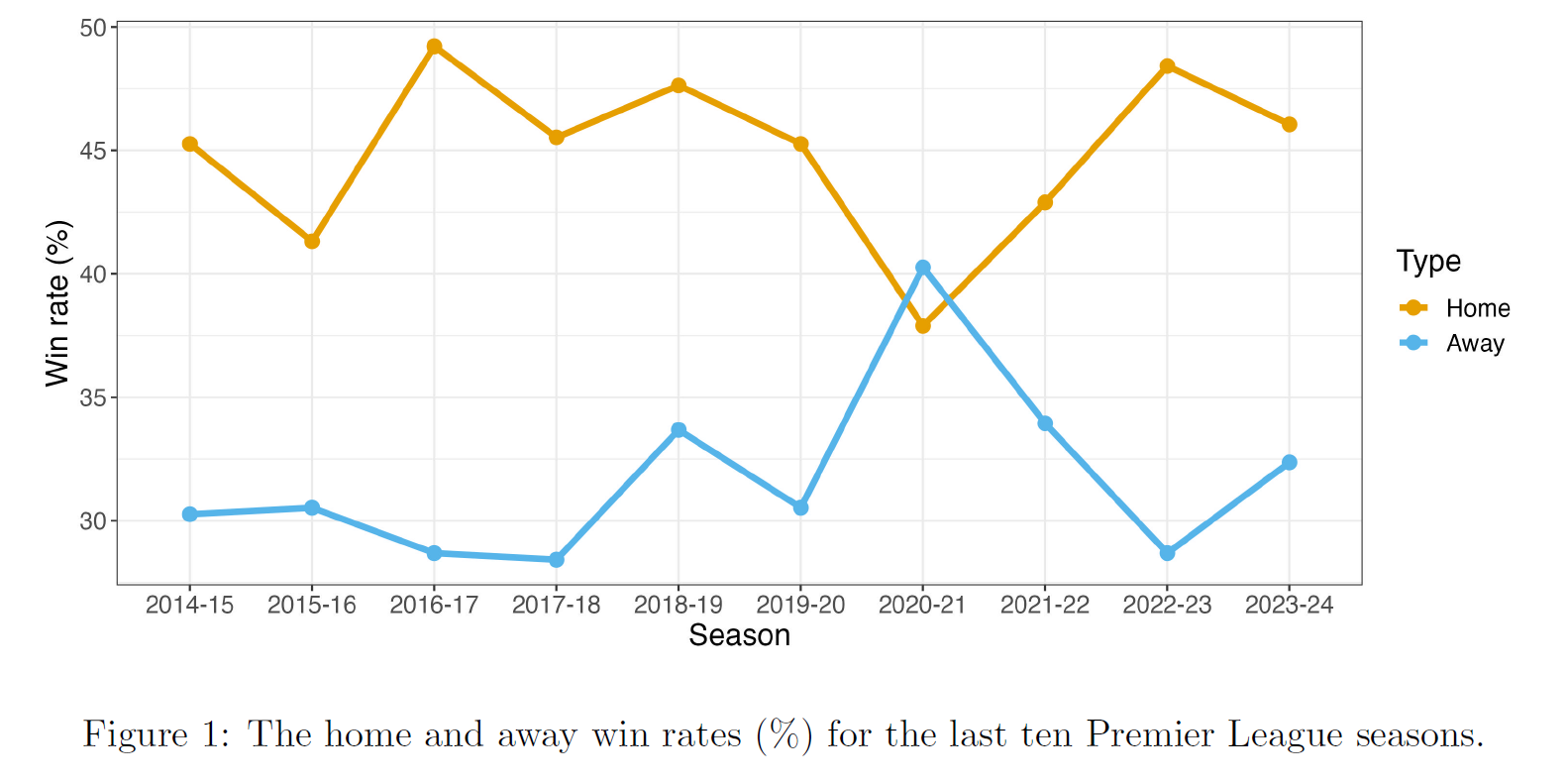
In the years with fans, a clear home advantage can be seen: for example, in the 2016–17 season, there was a 20% difference in home win rate over away win rate, so that a team was 1.7 times more likely to win at home than away. With fans returning, the seasons since the pandemic have seen the home win rates return to pre-pandemic levels.
A clearer link is gained by performing a Student’s t-test. A Student’s t-test allows for a comparison between two groups (in this case, the 2020–21 season against the other nine seasons). Applying this test to the average attendance per season and the away win rate shows a significant correlation of -0.72 (with a significant 5% level p-value of 0.02), suggesting that higher fan attendance leads to a lower away win rate. Hence, we can conclude that the attendance of fans has a statistically significant effect on the away win rate.
The findings of Figure 1 are further explored by looking at the rolling home win rate since the 2014–15 season (Figure 2). A significant drop is observed during the 2020–21 season, with the rate slowly returning to the pre-pandemic levels since the return of fans. Performing a Student’s t-test on both the home and away win rates for the 2020–21 season against the other nine seasons, a statistically significant difference is observed during the 2020–21 season at the 5% level (Home: p-value = 1 x 10−5, Away: p-value = 9 x 10−7). This provides further statistical evidence that, across the league, home fans are having a positive impact on their team’s results.
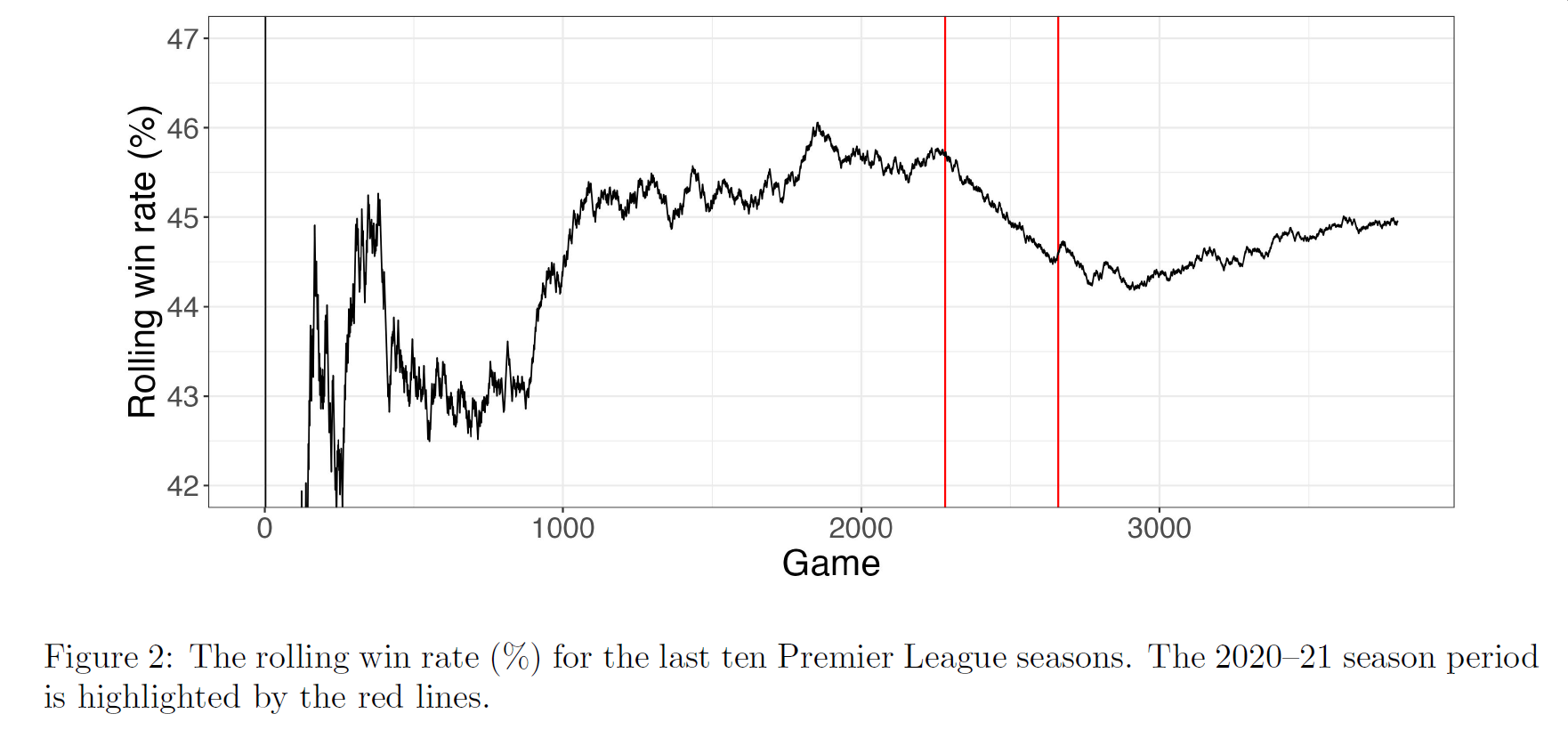
Impact of each team’s fans
Quantifying the impact Home fans pride themselves on the impact they have on helping their team win, as they rightly should given the findings above. Indeed, fans often claim that they are the ‘best fans’. But how much truth is there in each fanbase’s claim?
Using the 2020–21 season, it is possible to estimate the impact that each team’s fans have on their home results. To do this, a sensible start might be to look at the difference in home win rates between pre-pandemic and the 2020–21 season for each team. However, a team may have a lower/higher win rate solely due to a difference in form that season. Instead, the proportion of total points that have come from home games in a season is investigated. This way, the overall form of a team is adjusted for, so that instead, the home form is considered relative to the away form. To formalise this investigation, a metric, called the Home Fans Factor (HFF), is calculated and is defined as:

The non-pandemic seasons in question are the last ten years: seasons 2014–15 to 2023–24 (excluding 2020–21). The HFF is only calculated for the 20 teams that were in the Premier League in the 2020–21 season. A positive value indicates that the proportion of points from home games has decreased in the 2020–21 season for that team, indicating that the home fans normally have a positive impact. A negative value indicates the contrary.
The Home Fans Factor The top/bottom three HFFs are shown in Figure 3. Fulham was shown to have the largest HFF value, implying that the presence of Fulham fans has the greatest positive impact on the result for any team in the Premier League. On the other end, Southampton was shown to have the lowest, implying that they play better at home without fans present.
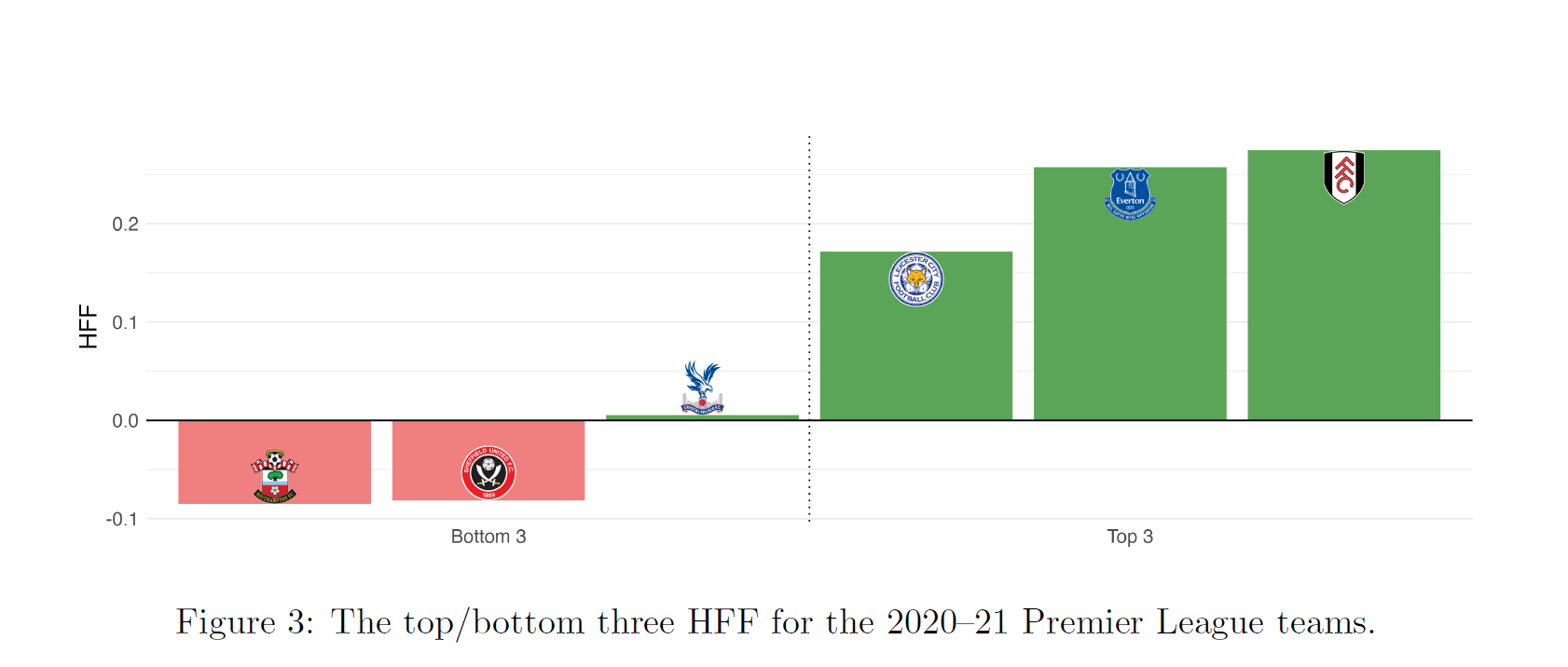
The factor for all the teams is shown in Figure 4. As the overall home win rate has decreased across the league when the fans are not present, it is no surprise that the HFF is positive for almost all of the teams; the exceptions being Southampton and Sheffield United. These two teams seem to prefer playing in an empty stadium — perhaps they don’t deal with fan pressure as well. This begs the question: why those two clubs? Is there something specific about their stadiums?
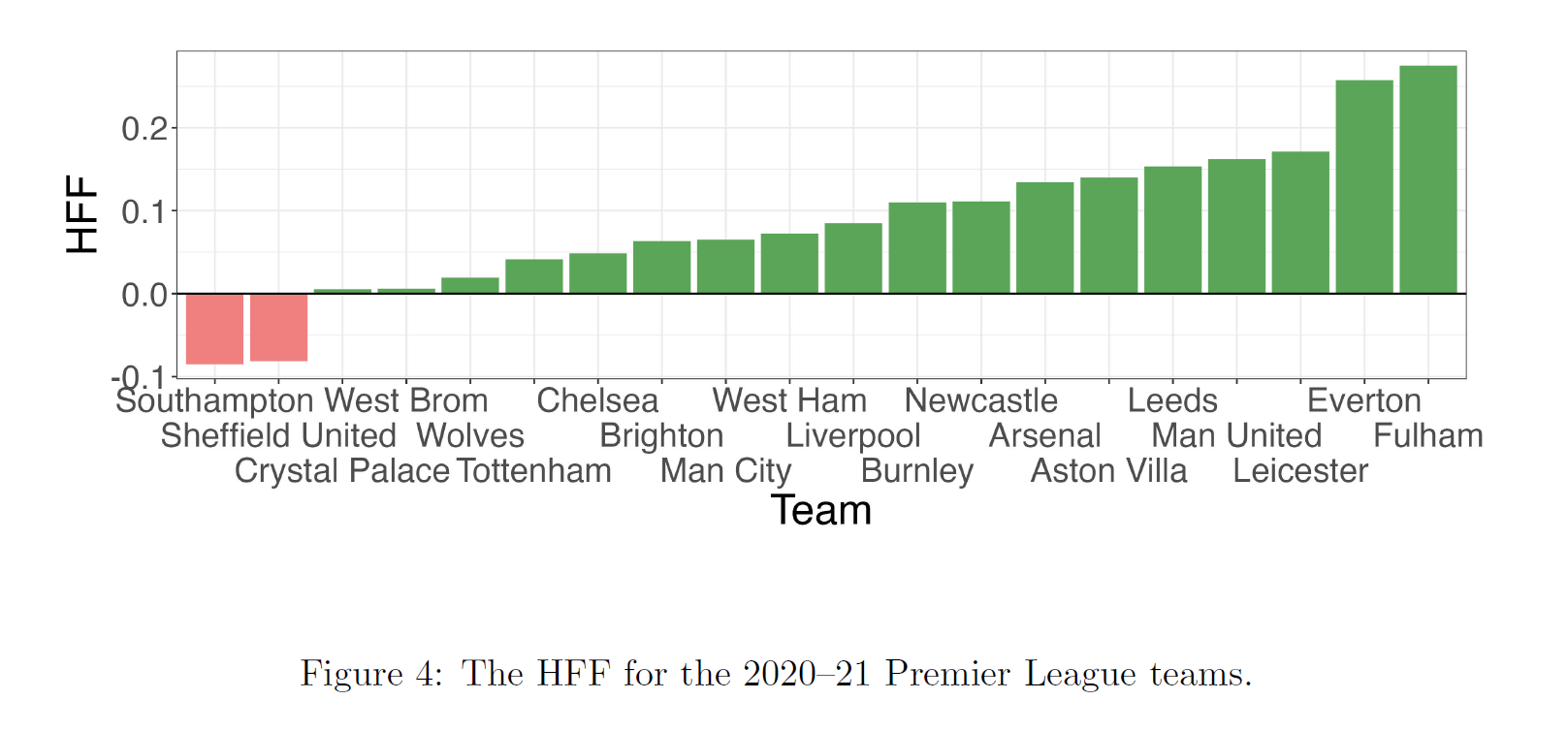
Figure 5 shows the HFF against the stadium capacity for each 2020–21 Premier League team. No significant correlation is observed, suggesting that while the presence of fans is important, the amount is not. The team with the largest HFF (Fulham) also has one of the lowest capacities. Despite Fulham not being known for its particularly rowdy atmosphere, compared to places like Liverpool’s Anfield, the team can probably play with slightly less pressure. So, perhaps the best performances at home come from a gentler atmosphere. These findings are in agreement with those found in the literature: Pollard and Armatas8 found that the attendance as a proportion of capacity had almost no impact on a home team’s outcome. Additionally, Pollard6 and Werlayne Leite and Pollard9 both found that moving to a new stadium did not improve results. Generally, a team will move to a larger stadium (hence the move), so these findings suggest that increased capacity does not influence outcome.
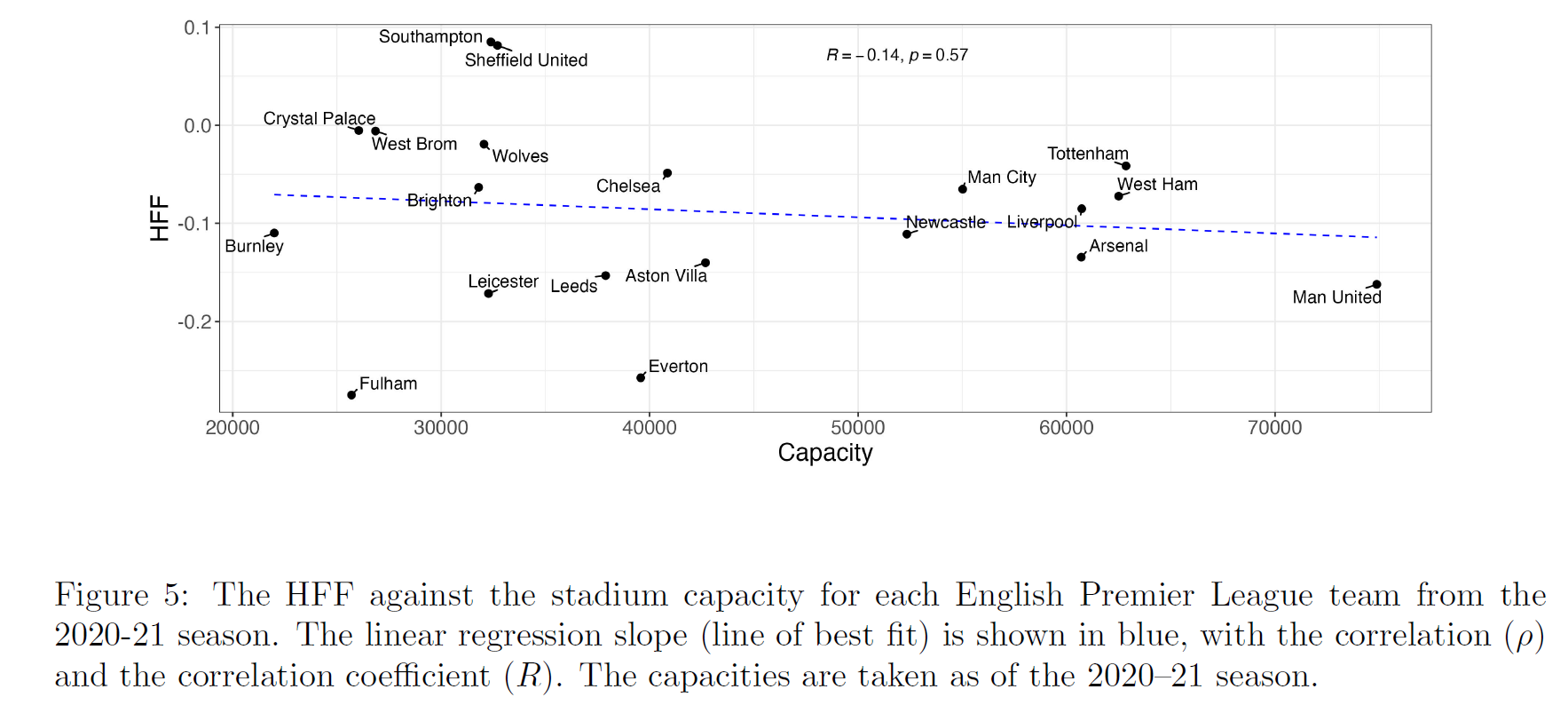
Did the pandemic change the support of any teams? While the focus so far has been on quantifying the impact of the home fans using the 2020–21 season, it is also possible to use the HFF metric to obtain additional discoveries on whether the pandemic caused any changes in how the Premier League teams perform in front of their fans. To do this, the HFF comparing the seasons before 2020–21 to those after (this excludes the 2020–21 season) was calculated. This measure assesses whether the home advantage has changed from pre-pandemic to post-pandemic. Two key discoveries were found:
- Watford was found to have the largest HFF (0.27), showing that their fans have become more impactful since they have returned to the stadiums
- Crystal Palace had the most negative HFF (-0.11), indicating that the team struggles more at home now than before the pandemic.
Clinical finish
The presence of home fans was shown to decrease the away win rate on average across the English Premier League. The 2020–21 season was the only season in the past ten years which had a higher away win rate than home, causing a substantial drop in the rolling home win rate in the modern era.
A new measure, the Home Fans Factor (HFF), was used to quantify the impact that each team’s fans have on their home performance. The measure compared the performance of the Premier League teams in the 2020–21 season, in which there were almost no fans, to the other nine seasons in the past ten years.
According to the HFF metric, Fulham was shown to have the most impactful fans. On the other end of the scale, Southampton had the worst HFF metric, indicating that the team plays better without fans. Of all 20 teams considered, only Southampton and Sheffield United played worse when fans were present. The measure was also used to compare the pre-pandemic seasons to the post-pandemic seasons, showing that Watford’s fans have become more impactful since the pandemic. Conversely, Crystal Palace appear to be struggling at home now, compared to before the 2020–21 season.
No correlation was discovered between the capacity of a stadium and the HFF, which is in agreement with the general literature consensus. This suggests that whilst the presence of the fans is important, the actual quantity of fans is relatively unimportant.
References
- Armatas, V. and Pollard, R. Home advantage in Greek football. European Journal of Sport Science, 14(2):116–122, 2014. doi: 10.1080/17461391.2012.736537
- Del Coso, J., de Souza, D.B., López del Campo, R., Blanco-Pita, H. and Resta, R. The football championship is won when playing away: difference in match statistics between the winner and the second-place team in Laliga. International Journal of Performance Analysis in Sport, 20(5):879–891, 2020. doi: 10.1080/24748668.2020.1801201.
- Gomez, M.A., Gómez-Lopez, M., Lago, C., and Sampaio, J. Effects of game location and final outcome on game-related statistics in each zone of the pitch in professional football. European Journal of Sport Science, 12(5):393–398, 2012. doi: 10.1080/17461391.2011.566373.
- Nevill, A., Balmer, N. and Williams, M. Crowd influence on decisions in association football. The Lancet, 353(9162):1416, 1999.
- Oberhofer, H., Philippovich, T., and Winner, H. Distance matters in away games: Evidence from the German football league Journal of Economic Psychology, 31(2):200–211, 2010. doi:10.1016/j.joep.2009.11.003.
- Pollard, R. Evidence of a reduced home advantage when a team moves to a new stadium. Journal of sports sciences, 20:969–73, 2003. doi: 10.1080/026404102321011724.
- Pollard, R. Home advantage in football: A current review of an unsolved puzzle. The Open Sports Sciences Journal, 1:12–14, 2008. doi:10.2174/1875399X00801010012
- Pollard, R. and Armatas, V. Factors affecting home advantage in football World Cup qualification. International Journal of Performance Analysis in Sport, 17(1-2):121–135, 2017. doi: 10.1080/24748668.2017.1304031.
- Leite, W., Giardina, M., Almeida, C.H. and Pollard, R. Home advantage in football after moving to a new stadium: evidence from European professional teams. International Journal of Sport and Exercise Psychology, 21(4):750–760, 2023. doi: 10.1080/1612197X.2022.2078855.
Fabio Feser is a PhD student in the department of mathematics at Imperial College, London. This article was a finalist for the 2024 Statistical Excellence Award for Early Career Writing.
You might also like: How data decided Jurgen Klopp’s replacement
Photo: London, UK – March 10 2019: the fans shout during the match of Premier League between Chelsea and Wolverhampton Wanderers, Stamford Bridge stadium. Silvi Photo/Shutterstock




